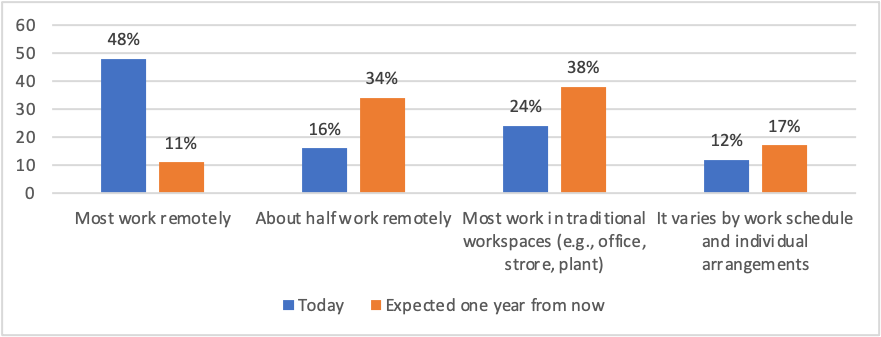In March 2020, the world suddenly changed in significant ways. As the coronavirus raged around the globe, many companies were forced to either completely shut down or to quickly shift to a digital workforce where some or all employees operated out of their homes. Despite the fact that many companies had already been involved to some degree in what has been called “digital transformation,” the pandemic increased the rate of this transition according to 65% of the respondents to our survey.
Still, many organizations are operating in a hybrid environment with some employees working on-site and others working remotely. About 25% of respondents say their employees are working in traditional workspaces—48% say they’re working remotely. Keep in mind that these results are from February-March 2021. As virus concerns have ebbed and vaccines have become more widely available, the number of employees in traditional settings has likely increased.
However, all evidence points to some level of digital transformation in the long haul.
Remote Work Likely to Continue
When asked to look ahead at what their workforce might look like in the future, 34% of respondents predicted that a year from now, about half of their workforce would still be working remotely.
There have, in fact, been a number of announcements from major organizations indicating that they intend to have at least some portion of their workforce working remotely in the future. In April 2021, FlexJobs reported on “30 Companies Switching to Long-Term Remote Work.” These included Amazon, American Express, Capital One, Facebook, Lincoln Financial, and Microsoft, among others.
The forced experiment that COVID-19 prompted forced employers to embrace digital transformation faster than ever expected. They’ve learned a lot over the past several months, especially about the many benefits that remote work can offer both employers and employees.
SHRM points to research by Mercer indicating that “productivity was the same as or higher than it was before the pandemic.” This was true for companies with employees working remotely as well as in traditional settings. Companies that had remote-work programs prior to the pandemic had already reported on the benefits achieved, including better productivity, employee loyalty and longevity, and improved work-life balance.
Hybrid Workplaces Will Become the Norm
Based on our survey, we predict that hybrid workforces will become the norm as we move beyond the pandemic—34% of our respondents say that about half of their workforce will be remote and 17% say it will vary by schedule and individual arrangements.
Survey Question. Where do employees in your organization work now, and where do you think they will work one year from now?

While most respondents are indicating that they hope to bring much of their fully remote workforce back to the office to some degree, they also indicate that these arrangements will be more flexible in the future.
The ability to offer flexibility to employees in terms of work setting can be a great tool for acquisition and retention. It also offers employers the ability to draw from a broader labor pool as being physically located near corporate offices would no longer be a requirement in a digital environment.
How To Do It Remains Unknown
While employers predict that they will likely operate in some form of hybrid environment in the future, they remain uncertain about exactly what the process looks like for bringing at least some portion of their currently remote workforce back into physical settings.
Three-fifths (60%) of our respondents expressed uncertainly about how and when to bring employees back to the physical workplace. This suggests that some employers either have not reached out to their employee base to understand their remote working preferences or they are struggling to determine the resources needed to support a digital workplace over the long term.
One challenge that a hybrid workforce presents is related to culture. Two-fifths of respondents (37%) indicate there is a cultural divide between those who can work remotely and those that cannot. This suggests the need for better policies and communication to help convey which positions, and individuals, may be appropriate for remote work and which may not, and how these decisions will be made.
In our next post, we take a look at our third major finding: companies are failing to use the tools necessary to support their digital workforces.



